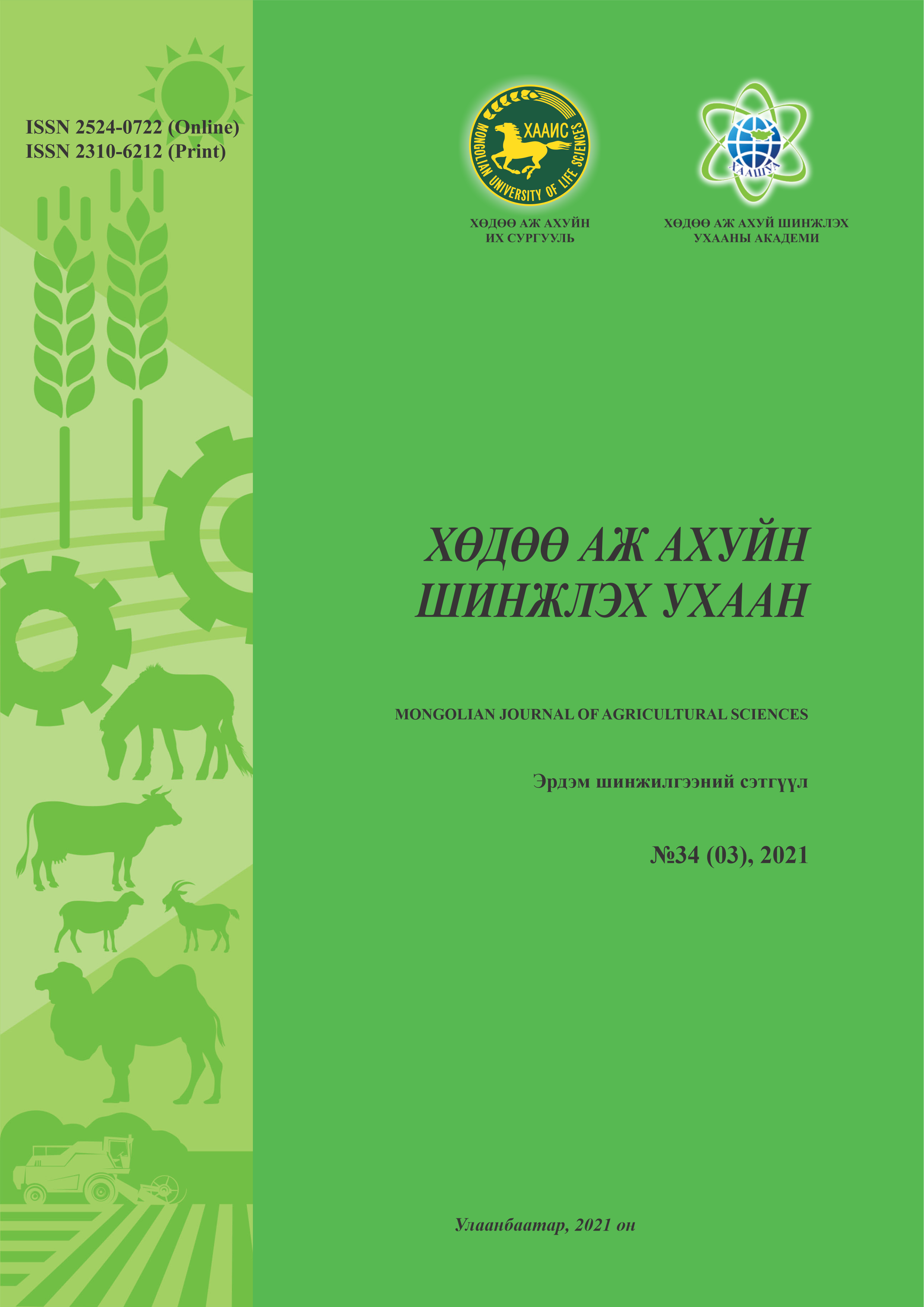Effect of rangeland production and quality for livestock body weight
DOI:
https://doi.org/10.5564/mjas.v34i3.1918Keywords:
Livestock age, sex, herd structure, plant palatability, rangeland degradation, forageAbstract
This study was done on the steppe in Altanbulag soum in Tuv Aimag and in Khashaat soum in Arkhangai Aimag, provinces. Animal body weights, age, sex and grassland biomass, were measured every three months from April 2017 (spring) through to December 2018 (winter). This was done for five herders at Altanbulag and five herders at Khaashat. During this study the climate was similar to average conditions in 2017 and 2018. For a large part of the study period, the herbage mass was less than 0.5t dry matter per hectare, particularly in Altanbulag. Desirable species were approximately 90% of the total herbage mass. General experience is that when there is less rain early in summer total grassland growth is less for that year. However, the generally low levels of grassland growth in these two regions arguably reflects grazing pressures more so than a climate effect. The total held by herders varied from less than 200 to 1000. In Altanbulag soum, where overall Aimag stocking rates among the surveyed herders were lower than in Khashaat soum, the herders reduced their total SE by about 50% over the two years of the survey. In Khashaat the reduction was about 30%, as these herders had lower stocking rates to start with. The results presented here, show the substantial increases in livestock numbers that have occurred, the climatic conditions that limit grassland growth to four months over summer, the harsh winters that are a major constraint on grasslands and livestock, the low levels of grassland growth that make the system ‘severely feed limited’ and the relatively undeveloped livestock production systems that could be more efficient. The data presented show that there are considerable inefficiencies in their livestock production systems. There is a high proportion of males to females, resulting in poor breeding practices and little possible genetic gain. It is unclear the extent to which herders perceive differences in the income obtained from male or female animals. The data suggest they do, as males are marginally more likely to be disposed of than females. The animal growth rates estimated from the data obtained, while being reasonable are below what could be achieved. The combination of over-grazing and severe winters means that animals do not reach their mature body size until four years of age. The estimates of animal growth rates show that they are getting less nutrients from the grassland than desirable. The low herbage mass recorded through 2017/2018, often below 0.5 t DM/ha, limits the intake rate of animals and increases their energy consumption to eat and digest the available grass.
Бэлчээрийн ургамалын чанар, бүтээмж малын амьдын жинд үзүүлэх нөлөөлөл
Судалгааг хээрийн бүсийн Төв аймгийн Алтанбулаг, Архангай аймгийн Хашаат сум бүрд 5, нийт 10 малчин өрхөд байгаа малыг нас, хүйсээр ялгаатайгаар ижилсүүлэн ээмэглэн, жинлэв. Ургамалын судалгааг зонхилогч бүлгэмдэлд зүйлийн бүрэлдэхүүн, бүрхэц, ургацыг тодорхойлов. Судалгааг 2017-2018 онуудад 3 сар тутамд хийж гүйцэтгэв. Хоёр суманд ялангуяа Алтанбулагт даац нэг га-д 0.5 тонноос бага байна. Учир нь Алтанбулагт өрхүүд малын тоогоо 50%, Хашаатад 30%, бууруулсантай холбоотой. Өрхүүд 200-1000 хүртэлх хонь/толгой малтай ба Хашаат, Алтанбулаг сумаас 15%-иар бага байна. Өрхүүдийн нийт бэлчээрийн талбай ойролцоогоор 4700-4900 га-д хэлбэлзэж, Хашаатад бэлчээрийн даац Алтанбулагыг бодвол арай бага байна. Эм хонины амьдын жин 4-5 насандаа дээд хэмжээндээ хүрч (45-50 кг) байхад эр хонины өсөлт үргэлжлэн 80 кг хүрч байна. Нийт эм хонины 6-14%-ийг л 3-4 настай хургатай хонь эзэлж байсан бол 54% нь 5-6 настай хургатай хонь бүрдүүлж байлаа. Хавар 4 сард төллөсөн хурга намар дунджаар 25 кг буюу өдөрт 180 граммаар жин нэмэгдэж байлаа. Зуны хугацаанд (2017 оны 5-9 сард) 1-2 настай буюу >3 настай хонь дунджаар 89-97 грам/өдөр жинг нэмж байна. Ишиггүй 4 настай ямаа дунджаар 40 кг жинтэй байна. Сүрэгт 2-3 настай ишигтэй ямаа 2-13%-ийг, 4-5 настай ишигтэй ямаа 20-27%-ийг бүрдүүлж байна. Хавар төрсөн ишиг намар нь 21 кг ба төрснөөсөө хойш өдөрт 105 грамм нэмэгдсэн. 1-2 ба >3 настай ямаа 2017 оны хавраас намар хүртэл 44-73 гр/өдөр нэмэгдсэн. 4 настай эм үхэр жингийн нэмэгдлээр дээд цэгтээ хүрч 380 кг болж байна. Сүргийн 69% нь 2 настай эр үхэр, 6% нь 3 настай 25% нь 4 настай үхэр байв. Тугал намар хүртэл өдөрт 550 грамм жингийн нэмэгдэлтэй байна. 1-2 ба >3 настай үхэр 290-430 гр/өдөр жингийн нэмэгдэлтэй байв. 5 настай адуу жингийн хувьд ахиу (300 кг) байсан. 2 настай даага зуны хугацаанд өдөрт 90 гр, 3-4 настай адуу 340 гр/өдөр жинтэй байлаа. Малчин өрхүүдийн мал аж ахуйн үйлдвэрлэл үр ашиг багатай байна. Сүргийн бүтцийн хувьд эр мал эм малаасаа их байгаа нь үржлийн хийгээд генетикийн хувьд маш ядмаг байдлыг үүсгэж байна. Малчид эр мал эм малын өгөх өгөөжийн талаарх ойлголттой байгаа эсэх нь тодорхойгүй байна. Малын амьдын жингийн өсөлтийн үзүүлэлтийн тоон мэдээллээс харахад хүрч болохуйц жингийн нэмэгдлээс доогуур төвшинд байна. Малын амьдын жингийн өөрчлөлтөөс харахад мал бэлчээрээс хэрэгцээт тэжээлээ авч чадахгүй байна гэж үзэж болохоор байна.
Түлхүүр үг: Малын нас, хүйс, сүргийн бүтэц, ургамлын идэмж, бэлчээрийн доройтол, тэжээллэг
Downloads
405
Downloads
Published
How to Cite
Issue
Section
License
Copyright (c) 2021 Gantuya Jargalsaikhan, Udval Gombosuren

This work is licensed under a Creative Commons Attribution 4.0 International License.
Copyright on any research article in the Mongolian Journal of Agricultural Sciences is retained by the author(s).
The authors grant the Mongolian Journal of Agricultural Sciences a license to publish the article and identify itself as the original publisher.

Articles in the Mongolian Journal of Agricultural Sciences are Open Access articles published under a Creative Commons Attribution 4.0 International License CC BY.
This license permits use, distribution and reproduction in any medium, provided the original work is properly cited.




